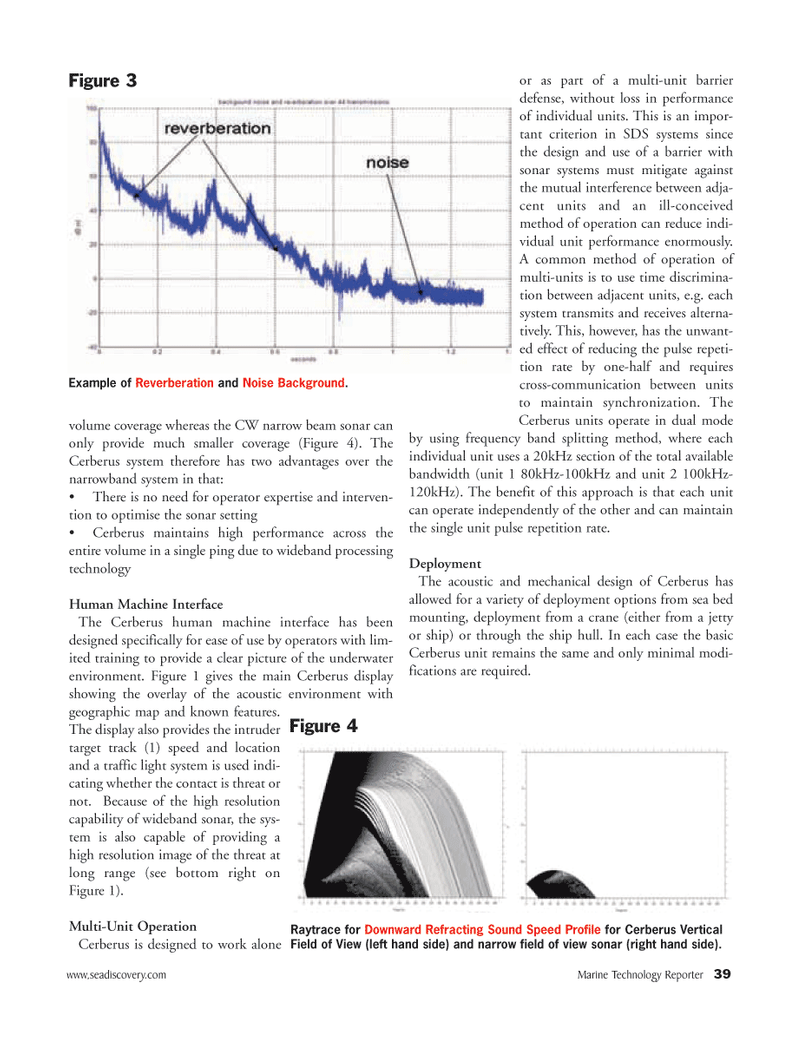
Page 39: of Marine Technology Magazine (November 2006)
Deep Ocean Exploration
Read this page in Pdf, Flash or Html5 edition of November 2006 Marine Technology Magazine
www,seadiscovery.com Marine Technology Reporter 39 volume coverage whereas the CW narrow beam sonar can only provide much smaller coverage (Figure 4). The
Cerberus system therefore has two advantages over the narrowband system in that: • There is no need for operator expertise and interven- tion to optimise the sonar setting Cerberus maintains high performance across the entire volume in a single ping due to wideband processing technology
Human Machine Interface
The Cerberus human machine interface has been designed specifically for ease of use by operators with lim- ited training to provide a clear picture of the underwater environment. Figure 1 gives the main Cerberus display showing the overlay of the acoustic environment with geographic map and known features.
The display also provides the intruder target track (1) speed and location and a traffic light system is used indi- cating whether the contact is threat or not. Because of the high resolution capability of wideband sonar, the sys- tem is also capable of providing a high resolution image of the threat at long range (see bottom right on
Figure 1).
Multi-Unit Operation
Cerberus is designed to work alone or as part of a multi-unit barrier defense, without loss in performance of individual units. This is an impor- tant criterion in SDS systems since the design and use of a barrier with sonar systems must mitigate against the mutual interference between adja- cent units and an ill-conceived method of operation can reduce indi- vidual unit performance enormously.
A common method of operation of multi-units is to use time discrimina- tion between adjacent units, e.g. each system transmits and receives alterna- tively. This, however, has the unwant- ed effect of reducing the pulse repeti- tion rate by one-half and requires cross-communication between units to maintain synchronization. The
Cerberus units operate in dual mode by using frequency band splitting method, where each individual unit uses a 20kHz section of the total available bandwidth (unit 1 80kHz-100kHz and unit 2 100kHz- 120kHz). The benefit of this approach is that each unit can operate independently of the other and can maintain the single unit pulse repetition rate.
Deployment
The acoustic and mechanical design of Cerberus has allowed for a variety of deployment options from sea bed mounting, deployment from a crane (either from a jetty or ship) or through the ship hull. In each case the basic
Cerberus unit remains the same and only minimal modi- fications are required.
Example of Reverberation and Noise Background.
Figure 3
Raytrace for Downward Refracting Sound Speed Profile for Cerberus Vertical
Field of View (left hand side) and narrow field of view sonar (right hand side).
Figure 4
MTR#9 (33-48).qxd 11/13/2006 4:37 PM Page 39

 38
38

 40
40
